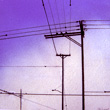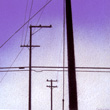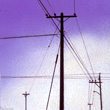|
|
|
|
||||
|
|
|
|
|
|||
|
|
||||||
|
|
|
|
||||
|
|
|
|
|
|||
|
|
||||||
| PRESS | home |
|
|

|

|

|
|
|
Resume Statement The Whole World In a Utility Pole... The Play of Lines in Color Fields by Dominic Barth The Santa Barbara Independent July 2nd, 1992 Review of show "Cities" Paige Neuhauser's show of eleven pastel drawings might be seen as a hodge-podge of styles echoing Charles Sheeler and Wanye Thiebaud. Any stylistic similarities are secondary, however, to Neuhausers own use of color in her compositions, to enhance not mood, not time of day, but design. The pastels are thickly applied and this lends weight to the planes of the structures; carefully bled edges define each shape. The exception, the photo real Santa Barbara exterior, shows Neuhauser's versatility with pastel. In the rest, her choice of technique emphasizes the line and rhythm of the city rather than a specific object. She has pared down the building to basics; streets are clear, skies are empty. Build of recognizable architecture, not abstract shapes suggesting a city, Neuhauser's designs show how her interposition of color increases in concert with tension in composition. She's made insightful statements on the influence an environment may have on the psyche of the dweller. In Chicago, one of four pastels with the same title, Neuhauser has composed the scene so that the eye has stopped,l on the right, by a corner of dark gray buildings backed by a muted red wall - dead end. You must move left, carried over the dark street by the shapes of streetlights; a small, vertical rectangle of light blue sky near the center almost helps your eye out of the picture, but a window of sky in the modern roof of the green-gray jail foils escape foils escape and brings you down again. Your trapped in a mute city of subdued hues, a static hole, with the sky somewhere outside. You'll know which Chicago I mean when you see it. Las Vegas and New Orleans sing where Chicago is quiet. Two dynamic drawings with sharply converging, descending parallels and counter current verticals, they are well-composed before hue is added. Selected use of unnatural color underscores the tensions of both compositions and emphasizes the line of Neuhauser's design, a facet ignored in other artists' abstract city scenes where application of color excuses slack coordination of the picture field. In New Orleans, an enormous antenna tower rises from the depths into a blood red sky. Deep red, but not screaming red, this moderation of extremes in a contemporary context is fresh and permissive. The controlled contrast of sky and reasonable, rich blue diagonal in a roof edge return you to the buildings, the stairs, the angles of a ventilation shaft. Other planes are restrained in color but, following the cue of the sky, there's life in the drawing and the whole benefits as the intersection of elements demand attention. We want to see if they're odd too, and controlled color contrasts let us look. Las Vegas, a study of an alley between casinos, has a similar intent. As the enormous red power line upright is barely controlled by a swiftly converging alley. It's behind-the-scenes Vegas. The air sizz les a patchy pale blue and the power lines hum. The blue shadow of the poles isolates them further from the canyon they've made between drab yellow and grey buildings. As in New Orleans, there's tension in the design, and the use of color servers to reinforce, not dominate structure, and lead one through the piece. Neuhauser has managed to walk the line between realism and precisionism / abstraction and done well. Her work is about the interplay of line. Her ability to create a strong linear composition and reinforce the kinetics of line with color enables one to appreciate the works as either literal, or geometric, or both. She reminds us how varied a city experience can be if one is open to it. City Shapes and Personal Space: Paige Neuhauser Leads an Intense Pleasure Trip Through American "Cities" by Laura Funkhouser Santa Barbara Metro June 25th/July 1st 1992 Down alleys sharply delineated by utilitarian walls, under power line grids, and through skylines punctuated with squat water towers, these are the parts of the city that are already antiquated, yet remain foreign to us. So too at the behemoth factories and warehouses, where their strangely adapted appendages, elemental to our phenomenon of industrial culture, have a magnificence of their own. American cities have been explored in the past in photography, painting and all mediums, but they have not met with the intense pleasure and understand of Paige Neuhauser. Neuhauser leads us through the narrow stree ts of industrial neighborhoods and into their individual characters with her series of pastels entitled "Cities". Giving a sense of portraiture and relying on her own exceptional sense of composition, texture, and penchant for strong hues, Neuhauser's photographic-based depictions of New York, Chicago, Las Vegas, New Orleans, San Francisco and Santa Barbara, represent each city in a different atmospheric mood. She uses the simple, abstract shapes of drainpipes, the Eiffel tower, TV antennae, windows, doorways and ladders, to create mysterious enclaves within the pastel cityscapes. Neuhauser allows neither romanticizing nor photo-realism to confine her exploration of the cities in feeling or form. In the two Chicago works, for example, the mood is softened with receding tobacco-colored streets and buildings, suggesting a rain soaked day and making the door recessions even more inviting. Whereas New Orleans has a flat, scorching vermilion red sky with a vertical staircase and rising power tower giving a sense of immediacy. And interplay of curvilinear forms and a patchwork of saturated colors give New York a jewel-like quality. And the light in San Francisco is the ocean blue of dawn or dusk, casting neon light on a solitary, but grand, building in bright yellow. Whether the pictures are spacious and looming city shapes or are personal studies of small, particular places within cities, Neuhauser imbues her unassuming compositions with animation and intrigue, allowing us access up to a point. While the imagination wanders these industrial corridors, their strangeness always keeps us from figuring out exactly why these works draw us in. The particularly striking work, Las Vegas, is a view down an alley paralleled by a network of electrical wires and neon shadows, carrying the juice of the city like veins. These conduits are a tiny part of a huge living thing that houses and transports raw materials, like an umbillical cord on which the cities lives are dependent. A Window Seat by Kerry Blankenship Santa Barbara Independent September 12th, 1991 (a review of Arlington Avenue) In a series of eight dramatic and different paintings, Paige Neuhauser's "Arlington Avenue" exhibit has given one apartment building its fifteen minutes of fame - and maybe even immortality. The building, an apartment complex located directly across the street from Paige Neuhauser Fine Art on Arlington Avenue, is one that Ne uhauser has only become too familiar with. Neuhauser not only works in her gallery, but lives upstairs as well, leaving her as the sole witness to the buildings constantly changing composition, through different angles, seasons, and times of day. In the series, Neuhauser paints with oils to bring the color and personality of the building to the canvas. A realistic interpretation is refreshing and stunningly captures many standard aspects of most buildings: a plain facade, windows, a drain pipe, a television antenna, electrical and telephone wires, and a palm tree. Her vibrant colors and varied angles bring each of these everyday necessities (and compositional elements) to live. The paintings, all named after months of the year, reflect the building in daylight, dusk, full darkness, and of course, fog. In March, April, and August, the rich blue sky creates a striking contrast to the bleach-white brightness of the apartment building. The white fog in June, on the other hand, coupled with the white of the apartment building, brings added detail to the dark lines of a telephone pole and the wires that stretch across to it. The paintings would seem incomplete without the darkness provided by the lines of the telephone pole and the accompanying wires. In the most reflective - and heart-wrenching - of the series, June 27th, 19 90, a pink, yellow, and white sky backdrops the apartment building as it is captured on the day of the Painted Cave Fire. More so than the others, the painting evokes mood through the combination of a gently roiling sky and a silent white building just before dusk. With this series, Neuhauser provides a month-by-month glimpse of the building's dramatic color and mood changes. Surprisingly, her method is so effective that it leaves one wondering about the people inside the building - maybe a series? COMMISSIONS: For information regarding Commissions, please contact Paige Neuhauser at 917.687.1772 or paige@paigeneuhauser.com |
||||
|
home
|
paintings
|
artcards
|
image use
|
bio
|
contact Copyright ©2016, Paige Neuhauser. All rights reserved. |